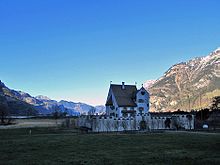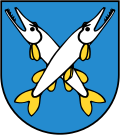Seedorf UR
| UR is the abbreviation for the canton Uri in Switzerland and is used to avoid confusion with other entries of the name Seedorf . |
| Seedorf | |
|---|---|
| State : |
|
| Canton : |
|
| District : | No district division |
| BFS no. : | 1214 |
| Postal code : | 6462 |
| Coordinates : | 689 535 / 193 106 |
| Height : | 452 m above sea level M. |
| Height range : | 433–2752 m above sea level M. |
| Area : | 15.48 km² |
| Residents: | 1858 (December 31, 2018) |
| Population density : | 120 inhabitants per km² |
|
Proportion of foreigners : (residents without citizenship ) |
5.7% (December 31, 2,014) |
| Mayor : | Max Aschwanden |
| Website: | www.seedorf-uri.ch |
| Location of the municipality | |

Seedorf is a municipality in the canton of Uri in Switzerland .
geography
Seedorf is located at the eastern foot of the Gitschen in the lower part of the Urner Reuss Valley on the southern shore of Lake Uri (an arm of Lake Lucerne ). The Gitschital , which is drained by the Palanggenbach, is located in the southwest of the municipality .
5.4% of the municipality is settlement area. The agricultural area is also modest with a share of 19.2%. The majority of the municipal area is covered by forest and wood (40.6%) or unproductive area (bodies of water and mountains; 34.8%).
Seedorf borders in the north on Lake Lucerne, in the northeast in the river bed of the Reuss on Flüelen , in the east on Altdorf , in the south on Attinghausen and in the west on Isenthal .
history
The St. Lazarus Benedictine Monastery and A Pro Castle are in Seedorf . The parish church of St. Ulrich and St. Verena was built in the 14th century.
Around 1970 to 1980 the A2 motorway was built, which has an exit at Seedorf and leads through the Seelisberg tunnel in the northwest of the village .
Attractions
population
The population grew by almost half between 1860 and 1900 - with a small slump in 1888 - (1860–1900: + 47.9%). In the following decade there was an equally sharp decline in the number of inhabitants, then a standstill in the 1910s. Since then, the population has almost quadrupled (1920–2005: +385.2%). The growth was only interrupted in the 1990s when the population stagnated.
| Population development | |||||||||||||
|---|---|---|---|---|---|---|---|---|---|---|---|---|---|
| year | 1860 | 1880 | 1888 | 1900 | 1910 | 1920 | 1930 | 1941 | 1990 | 2000 | 2005 | 2009 | |
| Residents | 403 | 506 | 444 | 596 | 413 | 412 | 497 | 535 | 1518 | 1509 | 1587 | 1680 | |
languages
The population speaks an Alemannic dialect. In the last census in 2000, 97.23% said German, 1.26% Italian and 0.33% Serbo-Croatian as their main language.
Religions - denominations
The population used to be fully members of the Roman Catholic Church. The denominational relationships in 2000 still show the original structure. 1367 people were Catholic (90.59%). In addition, there were 5.63% Evangelical Reformed Christians and 1.86% non-denominational. 18 people (1.19%) did not provide any information on their creed.
Origin - nationality
Of the 1587 residents at the end of 2005, 1531 (96.47%) were Swiss citizens. The immigrants come from southern Europe (Italy), central Europe (Germany and the Netherlands) and the successor states of Yugoslavia. At the 2000 census, 1,454 people (96.36%) were Swiss citizens; 24 of them had dual citizenship.
age structure
Due to the strong growth in the population, Seedorf has a relatively good age structure with many young people.
The last census in 2000 showed the following age structure:
| Age | 0–6 years | 7-15 years | 16-19 years | 20-29 years | 30–44 years | 45–59 years | 60–79 years | 80 years and more |
| number | 119 | 181 | 103 | 209 | 381 | 312 | 176 | 28 |
| proportion of | 7.89% | 11.99% | 6.83% | 13.85% | 25.25% | 20.68% | 11.66% | 1.86% |
politics
legislative branch
The municipal assembly is the legislature. It meets at least once a year.
executive
The seven-member municipal council forms the executive . He works part-time. The current mayor is Max Aschwanden (as of 2017).
economy
In 2005 there were 21 farms that offered work to 77 people and also used Alpine farming areas. Industry and trade employed 156 people in 20 workplaces, the service sector in 34 companies 119 people. Of the 852 employed people in Seedorf in 2000, 199 (23.36%) worked in their own community. In total, the place offered 385 jobs, of which 199 (51.69%) were occupied by locals.
Most of the 653 commuters do their work in other communities in the canton of Uri. Including 298 people in Altdorf, 77 in Schattdorf, 49 in Flüelen, 32 in Bürglen and 27 in Erstfeld. The most important places of work outside the canton were the municipalities of Schwyz , Stans and the city of Lucerne . There were also 186 commuters. These came mainly from Altdorf (36 people), Schattdorf (24), Attinghausen (23), Bürglen UR (22), Erstfeld (21) and Flüelen (18).
Born in Seedorf
- Leonard (* 1964), Swiss pop singer, presenter and songwriter
literature
- Helmi Gasser : The art monuments of the canton Uri, Volume 2: The lakeside communities. Edited by the Society for Swiss Art History GSK. Bern 1986 (Art Monuments of Switzerland Volume 78). ISBN 3-7643-1811-2 . Pp. 139-268.
Web links
- Official website of the community of Seedorf
- Hans Stadler: Seedorf (UR). In: Historical Lexicon of Switzerland .
Individual evidence
- ↑ Permanent and non-permanent resident population by year, canton, district, municipality, population type and gender (permanent resident population). In: bfs. admin.ch . Federal Statistical Office (FSO), August 31, 2019, accessed on December 22, 2019 .
- ↑ https://www.pxweb.bfs.admin.ch/Selection.aspx?px_language=de&px_db=px-x-0102020000_201&px_tableid=px-x-0102020000_201\px-x-0102020000_201.px&px_type=PX
- ^ Parish Church of Seedorf




